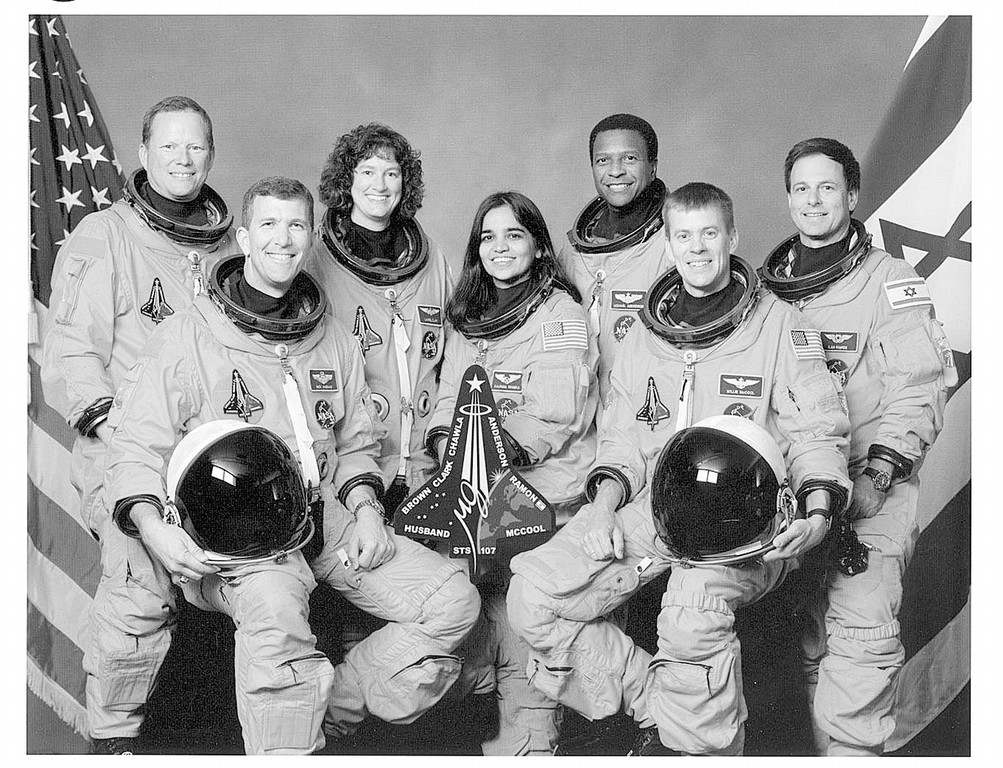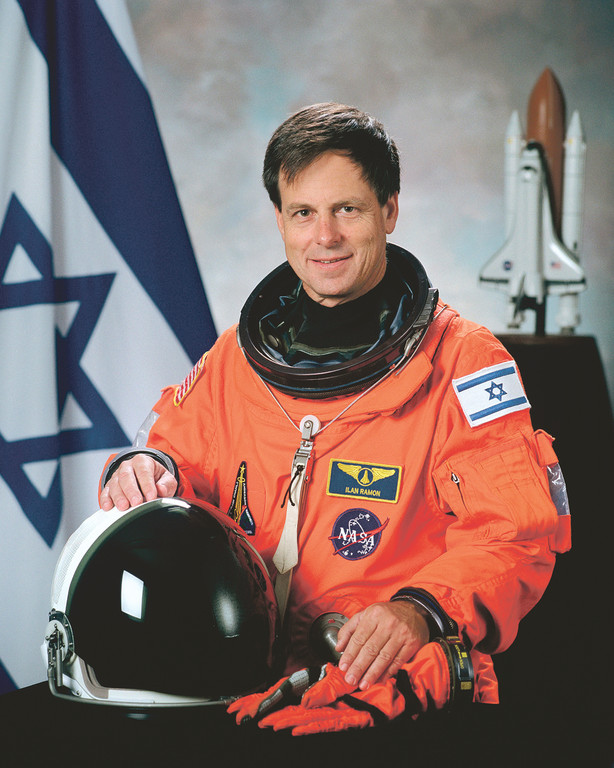Five Towners sense of pride for Ilan Ramon
Documentary on Ilan Ramon and Columbia shuttle
Ten years ago this week, the world watched as the son of a Holocaust survivor conveyed a message of faith, hope and survival from the height of achievement in a display of unity of purpose, only to later watch his and his crew mates untimely death.
On Thursday, January 31, at 10:30 pm, PBS WNET NY, Channel 13, will premiere Space Shuttle Columbia: Mission of Hope, the story of Israeli Astronaut Ilan Ramon on the 10th anniversary of the shuttle disaster.
Many can recall the great pride felt by Israel and the world Jewish community when Ilan Ramon suited up for his space trip and knowing that he was
determined to observe Shabbat and kashrut while in the space shuttle. This film traces Ilan’s life and the multiple historical ties of Jewish survival, ties leading to the fulfilling of a promise and a mission on the space shuttle.
“I grieve for Ilan Ramon and his son who was #1 in his pilot class and was killed in a training accident,” noted Rabbi Herschel Billet, Rav of the Young Israel of Woodmere. “This is a family which represents paying the price for Medinat Yisrael in blood. Because of people like them we have a Jewish State. The price is inordinately high.”
The focal point of the story is a miniature Torah that had been smuggled into Bergen Belsen concentration camp by a Dutch rabbi and was given to Joachim “Yoya” Yosef after celebrating his bar mitzvah in secret in the camp. The rabbi had Yoya promise to tell the story of the Torah, his bar mitzvah, and life in Bergen Belsen. Yoya survived and ultimately became a professor at Tel Aviv University specializing in radiation, aerosols and clouds. He wrote the Torah’s story in the Jerusalem Post in 1951 and also wrote a children’s book about the Torah and Ramon “Reach for the Stars: A Little Torah’s Journey.”
According to an obituary of Yoya by the International Radiation Commission, “Yoya was an expert on desert aerosols and became principal investigator on the MEIDEX remote sensing experiment on the Space Shuttle Columbia to measure aerosols from African dust storms over the Mediterranean and their relation to rainfall.” In that capacity, Yoya met Ramon who noticed the small Torah ark in Yoya’s office. Ramon asked to take the Torah along on his mission to tell the story, fulfilling the promise on a global stage, in front of millions.
Colonel Ilan Ramon’s mother was, he said, a “graduate” of Auschwitz, and the knowledge and strivings of a son of a survivor colored Ilan’s thoughts and actions, knowing how many died for being Jews and the need to reconstruct and protect the Jews’ ancestral home in Israel. Born in Tel Aviv, Ilan joined the Israel Air Force after graduating high school and fought in the Yom Kippur War in 1973, graduating from the Israel Air Force Flight School as a fighter pilot in 1974. He designed the attack on Iraq’s Osirak nuclear reactor in June 1981 and flew in position number eight, considered the most dangerous position. The Israelis suffered no casualties. He earned a degree in electronics and computer engineering from Tel Aviv University. He logged over 4,000 flight hours flying Israeli military aircraft. In 1997, Ilan was chosen to be an astronaut and began training at the Johnson Space Center in Houston, Texas in 1998.
“I think it’s very, very peculiar to be the first Israeli up in space,” Ramon said before his flight on the shuttle. “Especially because of my background.” He noted that his mother was a Holocaust survivor and his father fought for Israel’s independence, very similar to the backgrounds of many Israelis. He saw himself as a “symbol” and that he was “kind of the proof for them, and for the whole Israeli people, that whatever we fought for and we’ve been going through in the last century--or maybe in the last two thousand years--is becoming true.” He had also noted that, when speaking to other Holocaust survivors of his being an Israeli astronaut, “they look at you as a dream that they could have never dreamed of….So, it is very exciting.”
The documentary incorporates footage recorded by one of Ramon’s fellow astronauts, David Brown, NASA footage and interviews conducted by director Dan Cohen. The project, begun shortly after the accident, continued for seven years, with another three years to provide for its showing through PBS.
“Ever since I was a child I was fascinated by space exploration,” said Cohen. A documentary filmmaker, Cohen, won six Emmys as a producer of corporate and live television. At the time of the accident, he was looking for material for a documentary and noticed a small article about the Torah “buried in the back of a newspaper.” He said he thought it was a “good story” and a “new way to tell the Holocaust story to a new generation.”
A friend in NASA connected Cohen with Yoya Yosef who said, “’Anything I can do for my dear friend Ilan Ramon, you tell me what to do,’” recalled Cohen. “I heard that time and time again. That’s how I got started. It’s a powerful story, with many layers. It’s the journey of the human spirit, the hope of what is possible embodied in the Columbia crew.” They were the most diverse crew, with two women, one born in India, an African American, an Israeli, different religions, all highly educated, accomplished, intelligent. After training together for the mission, they had formed a family. “They showed the world what you can do when you work together for the greater good,” stressed Cohen. “It’s a powerful message—the hope for a better day.” He said that the movie “came out far better than I had envisioned.” The accident was “a searing moment for me, for all of us. I had done other things with space, this became more important.”
Cohen emphasized that the film has “multiple missions” and that Ilan felt the “promise deep in his heart to tell the story, to tell what happened in Bergen Belsen.” Cohen recounted that Yoya had told him that “Ilan knew that he had to do certain things symbolically to show who he was, to keep kosher, Shabbat. “ Ilan went to Rick Husband to get his permission. Rick Husband went to a rabbi to learn what the rituals were to be sure that Ilan was doing it correctly. “Husband’s faith was everything to him,” explained Cohen. “In the scene with the Torah, you can see the pride in Husband’s face. The crew understood the story and Yoya’s story.”
As was noted in the film, Ramon “carried the payload of history,’ and as he said about himself, “I am the representative of all the people of Israel, the State of Israel and Jewish people all around the world.” He “fulfilled the promise in a way never thought possible” and the Torah traveled “from the depths of hell to the heights of space…from the depths of despair to the height of hope.”
“I vividly recall the pride we all felt in seeing Ilan Ramon, an Israeli astronaut, join the Columbia space mission,” recounted Rabbi Zev Friedman, Rosh HaYeshiva at Rambam Mesivta High School in Lawrence, New York. “He was the youngest pilot in Israel’s historic strike against Iraq’s nuclear reactor. That itself made him a ‘hero.’ Most importantly, Ilan knew that he represented the entire Jewish community on his mission. He truly was a proud Jew! Rabbi Yosef Dov Soloveichik stated that there were two points of connection that every Jew has to the Jewish community as a whole. One is his or her identification with the covenantal community in so far as he or she accepts and observes the system of Torah and Mitzvos. A second aspect is the identification that every Jew has to the history and destiny of our people. Both of these aspects are integral. Ilan clearly personified an individual identification with the collective Jewish past. He made a point of this by bringing a Sefer Torah that survived Bergen-Belsen, a picture of Earth as seen from the moon drawn by a Jewish boy in Theresienstadt concentration camp and a microfiche copy of Tanach on his trip. He made a point of saying Kiddush when Friday night arrived and reciting Shema Yisrael as the Columbia circled over Yerushalayim.”
“One of the wonderful things (about the film),” added Cohen, “everybody watches this powerful story and takes away their own message. That people pay attention and think about it, how does the message in the film make a difference in my life. The messages are so powerful. Out of a tragic story is a message of hope.”
The film is dedicated to Captain Asaf Ramon, Ilan’s son, who died at age 21 when his plane crashed in a training mission in the Hebron hills in 2009. Ilan’s mother Tonya died in 2003 and his father Eliezer died in 2006. Ilan is survived by his wife Rona and three children. Joachim (Yoya) Joseph died in 2008.
For more information about the film go to missionofhopemovie.com

 61.0°,
Mostly Cloudy
61.0°,
Mostly Cloudy 







